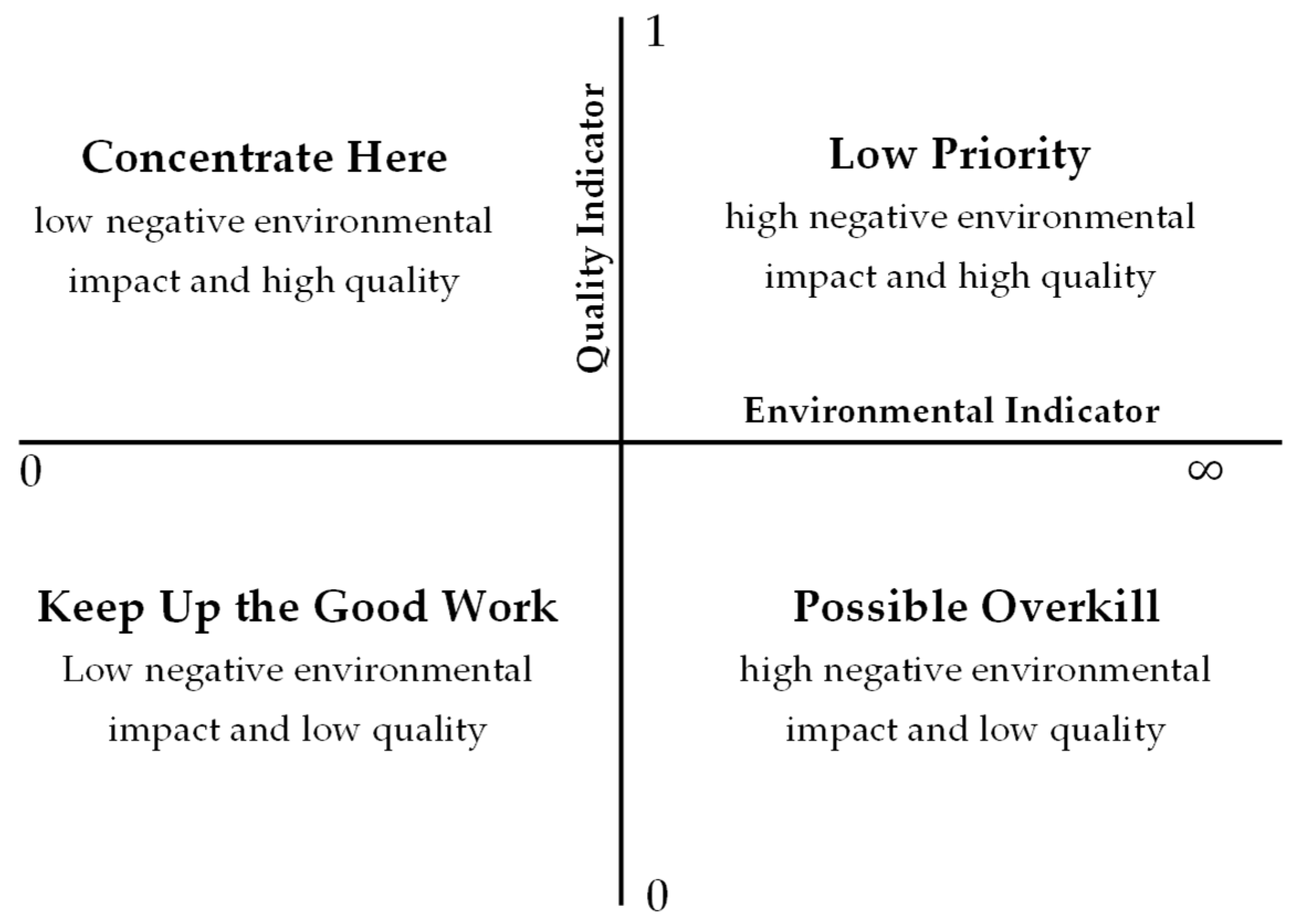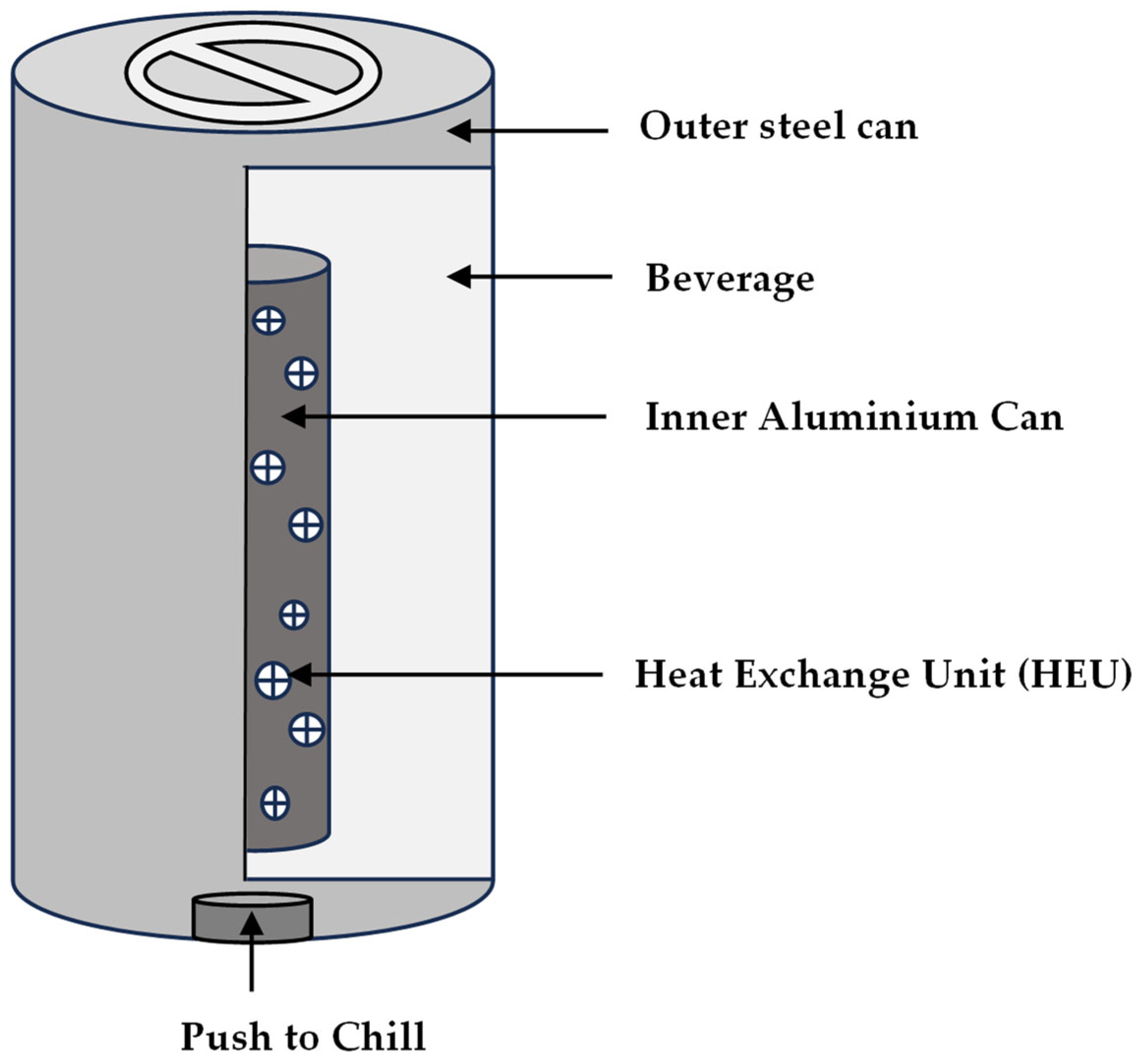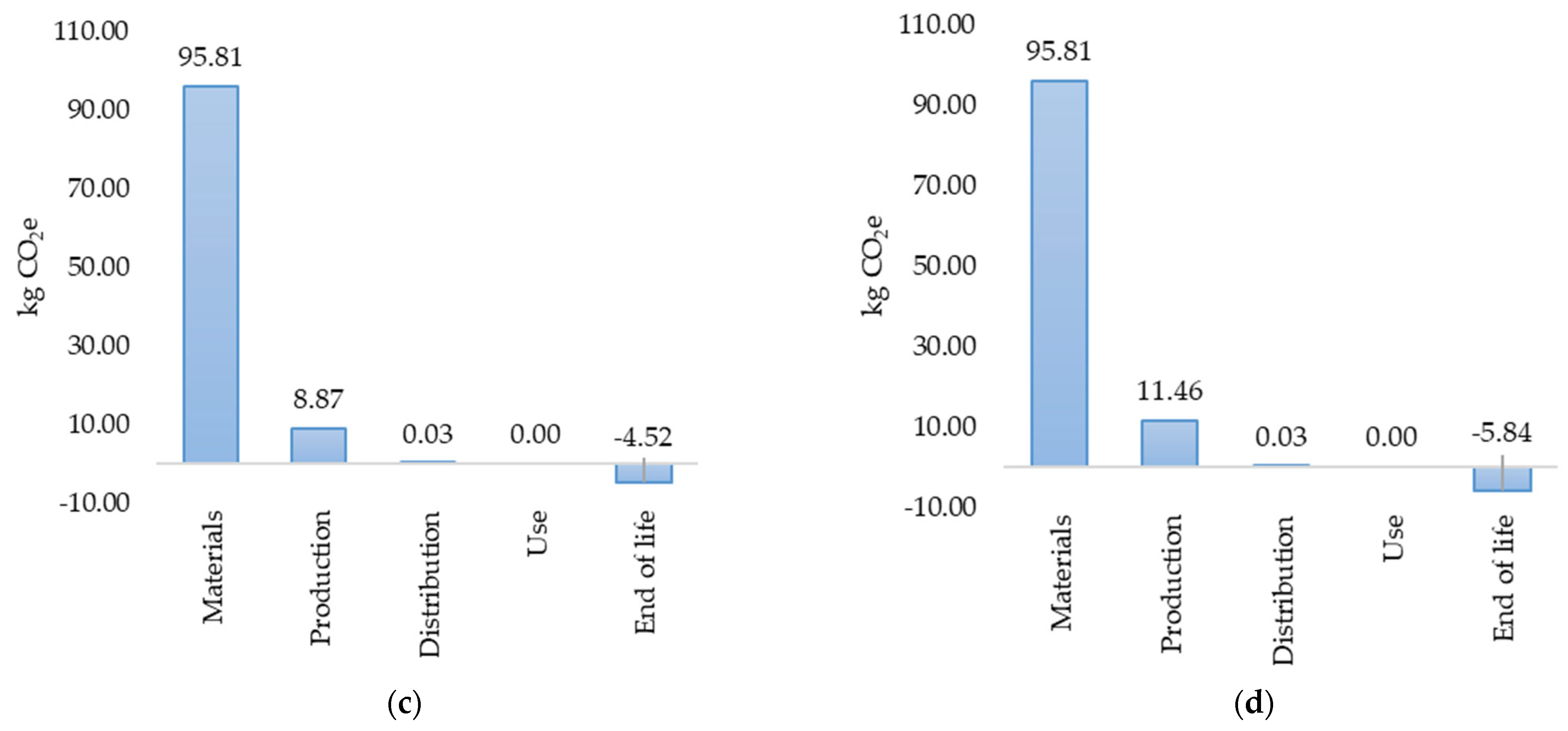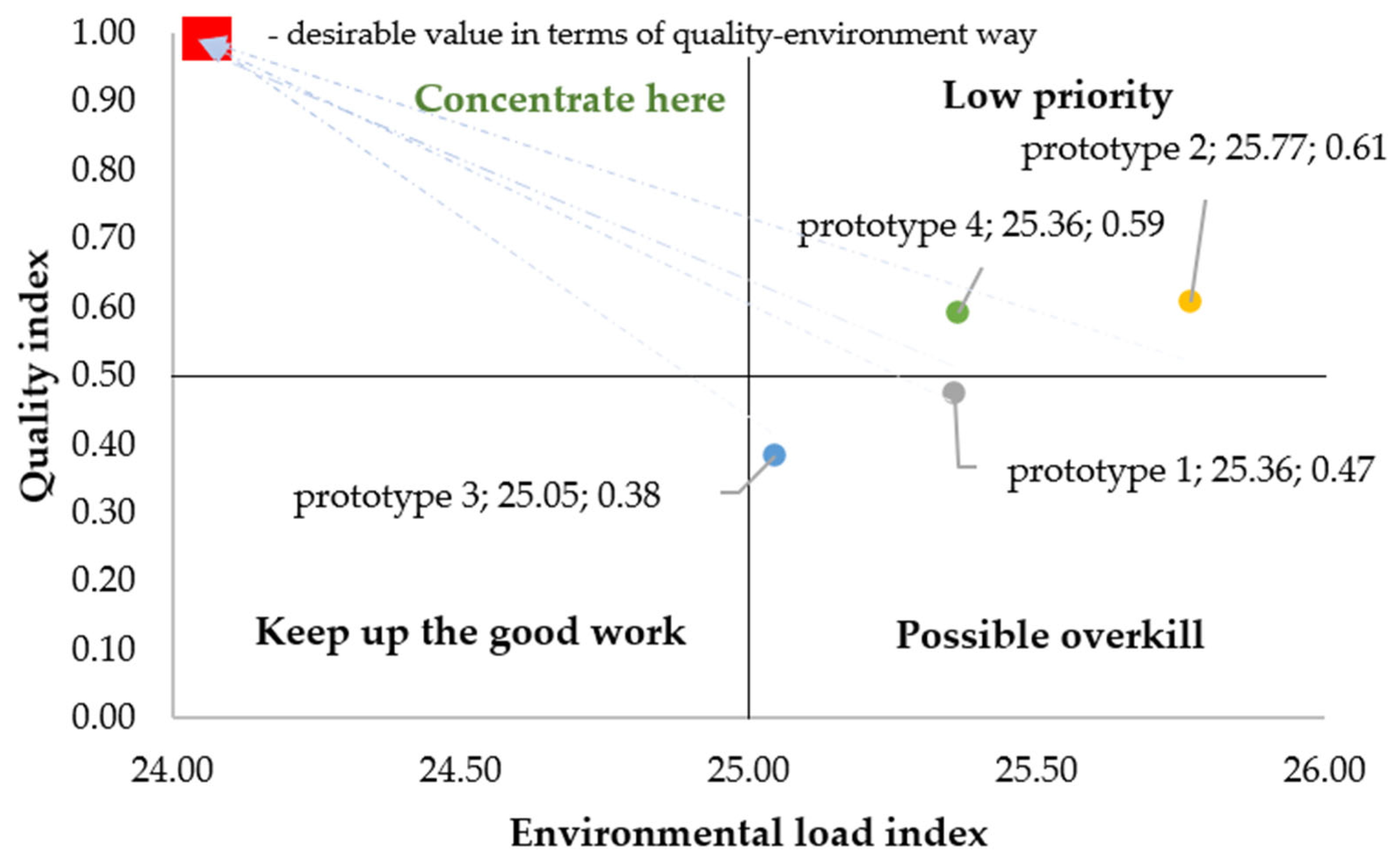Procedure for Aggregating Indicators of Quality and Life-Cycle Assessment (LCA) in the Product-Improvement Process
Abstract
:1. Introduction
2. Material and Method
2.1. Selecting a Reference Product and Defining the Research Goal
2.2. Obtaining Customer Expectations
2.3. Assessment of the Product Quality Level
2.4. Product Life-Cycle Assessment (LCA)
2.5. Integration of Product Quality Level with Life-Cycle Environmental Impact (LCA) and Interpretation of Results
3. Results
3.1. Selecting a Reference Product and Defining the Research Goal
3.2. Obtaining Customer Expectations
- height (mm)—the height often determines how large of a box a can be stored in;
- outer diameter (mm)—determines the firmness of the grip and the ease of holding the can by people with different grip sizes (child, adult);
- base diameter (mm)—determines the stability of the box;
- volume (mL)—should be adjusted to commonly desired can volumes;
- opening method—must be easy to open under various conditions;
- material—should meet food safety requirements;
- self-cooling system—should provide the appropriate temperature at a specific time.
3.3. Assessment of the Product Quality Level
3.4. Product Life-Cycle Assessment (LCA)
3.5. Integration of Product Quality Level with Life-Cycle Environmental Impact (LCA) and Interpretation of Results
- selection of a means of transport for transporting self-cooling cans;
- reducing energy use in the production phase of self-cooling cans;
- the use of appropriate materials that emit less CO2 (e.g., aluminum substitute);
- changing the way of opening the can;
- change in can volume.
4. Discussion
- assessment of the product life cycle and its alternatives in terms of any environmental burden criterion;
- customer’s assessment of the current quality of the product and its alternatives;
- aggregation of the product quality indicator with the life-cycle assessment indicator;
- determination of the main environmental burdens in the product life cycle, including the estimation of expected environmental burdens;
- Identifying the state of product development in terms of quality and the environment and directing it towards increasing product quality and minimising its negative environmental impact.
5. Conclusions
Author Contributions
Funding
Data Availability Statement
Conflicts of Interest
References
- Pacana, A.; Gazda, A.; Dušan, M.; Štefko, R. Study on Improving the Quality of Stretch Film by Shainin Method. Przem. Chem. 2014, 93, 243–245. [Google Scholar]
- Jaghbeer, Y.; Hallstedt, S.I.; Larsson, T.; Wall, J. Exploration of Simulation-Driven Support Tools for Sustainable Product Development. Procedia CIRP 2017, 64, 271–276. [Google Scholar] [CrossRef]
- Gajdzik, B.; Wolniak, R. Smart Production Workers in Terms of Creativity and Innovation: The Implication for Open Innovation. J. Open Innov. Technol. Mark. Complex. 2022, 8, 68. [Google Scholar] [CrossRef]
- Gajdzik, B.; Gawlik, R. Choosing the Production Function Model for an Optimal Measurement of the Restructuring Efficiency of the Polish Metallurgical Sector in Years 2000–2015. Metals 2017, 8, 23. [Google Scholar] [CrossRef]
- Gawlik, R. Methodological Aspects of Qualitative-Quantitative Analysis of Decision-Making Processes. Manag. Prod. Eng. Rev. 2016, 7, 3–11. [Google Scholar] [CrossRef]
- Ostasz, G.; Siwiec, D.; Pacana, A. Universal Model to Predict Expected Direction of Products Quality Improvement. Energies 2022, 15, 1751. [Google Scholar] [CrossRef]
- Miranda, J.; Pérez-Rodríguez, R.; Borja, V.; Wright, P.K.; Molina, A. Sensing, Smart and Sustainable Product Development (S3 Product) Reference Framework. Int. J. Prod. Res. 2019, 57, 4391–4412. [Google Scholar] [CrossRef]
- Vinodh, S.; Rathod, G. Integration of ECQFD and LCA for Sustainable Product Design. J. Clean. Prod. 2010, 18, 833–842. [Google Scholar] [CrossRef]
- Rathod, G.; Vinodh, S.; Madhyasta, U.R. Integration of ECQFD and LCA for Enabling Sustainable Product Design in an Electric Vehicle Manufacturing Organisation. Int. J. Sustain. Eng. 2011, 4, 202–214. [Google Scholar] [CrossRef]
- Sakao, T. A QFD-Centred Design Methodology for Environmentally Conscious Product Design. Int. J. Prod. Res. 2007, 45, 4143–4162. [Google Scholar] [CrossRef]
- Trappey, A.J.C.; Ou, J.J.R.; Lin, G.Y.P.; Chen, M.-Y. An Eco- and Inno-Product Design System Applying Integrated and Intelligent Qfde and Triz Methodology. J. Syst. Sci. Syst. Eng. 2011, 20, 443–459. [Google Scholar] [CrossRef]
- Neramballi, A.; Sakao, T.; Willskytt, S.; Tillman, A.-M. A Design Navigator to Guide the Transition towards Environmentally Benign Product/Service Systems Based on LCA Results. J. Clean. Prod. 2020, 277, 124074. [Google Scholar] [CrossRef]
- Sakao, T.; Kaneko, K.; Masui, K.; Tsubaki, H. Combinatorial Usage of QFDE and LCA for Environmentally Conscious Design. In The Grammar of Technology Development; Springer: Tokyo, Japan, 2008; pp. 45–59. [Google Scholar]
- Chevalier, J.L.; Le Téno, J.F. Requirements for an LCA-Based Model for the Evaluation of the Environmental Quality of Building Products. Build. Environ. 1996, 31, 487–491. [Google Scholar] [CrossRef]
- Romli, A.; Prickett, P.; Setchi, R.; Soe, S. Integrated Eco-Design Decision-Making for Sustainable Product Development. Int. J. Prod. Res. 2015, 53, 549–571. [Google Scholar] [CrossRef]
- Kobayashi, Y.; Kobayashi, H.; Hongu, A.; Sanehira, K. A Practical Method for Quantifying Eco-efficiency Using Eco-design Support Tools. J. Ind. Ecol. 2005, 9, 131–144. [Google Scholar] [CrossRef]
- Park, P.-J.; Tahara, K.; Inaba, A. Product Quality-Based Eco-Efficiency Applied to Digital Cameras. J. Environ. Manag. 2007, 83, 158–170. [Google Scholar] [CrossRef]
- Siwiec, D.; Pacana, A. Model of Choice Photovoltaic Panels Considering Customers’ Expectations. Energies 2021, 14, 5977. [Google Scholar] [CrossRef]
- Siwiec, D.; Pacana, A. A New Model Supporting Stability Quality of Materials and Industrial Products. Materials 2022, 15, 4440. [Google Scholar] [CrossRef]
- Hameed, A.Z.; Kandasamy, J.; Aravind Raj, S.; Baghdadi, M.A.; Shahzad, M.A. Sustainable Product Development Using FMEA ECQFD TRIZ and Fuzzy TOPSIS. Sustainability 2022, 14, 14345. [Google Scholar] [CrossRef]
- Haber, N.; Fargnoli, M. Sustainable Product-Service Systems Customization: A Case Study Research in the Medical Equipment Sector. Sustainability 2021, 13, 6624. [Google Scholar] [CrossRef]
- Vinodh, S.; Jayakrishna, K. Development of Integrated ECQFD, LCA and Sustainable Analysis Model. J. Eng. Des. Technol. 2014, 12, 102–127. [Google Scholar] [CrossRef]
- Zhang, Y. Green QFD-II: A Life Cycle Approach for Environmentally Conscious Manufacturing by Integrating LCA and LCC into QFD Matrices. Int. J. Prod. Res. 1999, 37, 1075–1091. [Google Scholar] [CrossRef]
- Ostasz, G.; Siwiec, D.; Pacana, A. Model to Determine the Best Modifications of Products with Consideration Customers’ Expectations. Energies 2022, 15, 8102. [Google Scholar] [CrossRef]
- Sullivan, G.M.; Artino, A.R. Analyzing and Interpreting Data From Likert-Type Scales. J. Grad. Med. Educ. 2013, 5, 541–542. [Google Scholar] [CrossRef] [PubMed]
- Pacana, A.; Siwiec, D. Analysis of the Possibility of Used of the Quality Management Techniques with Non-Destructive Testing. Tehicki Vjesn.-Tech. Gaz. 2021, 28, 45–51. [Google Scholar] [CrossRef]
- Wu, M.H.; Sadhukhan, J.; Mrphu, R.; Bharadwaj, U.; Cui, X.F. A novel life cycle assessment and life cycle costing framework for carbon fibre-reinforced composite materials in the aviation industry. Int. J. Life Cycle Assess. 2023, 28, 566–589. [Google Scholar] [CrossRef] [PubMed]
- Finkbeiner, M.; Inaba, A.; Tan, R.; Christiansen, K.; Klüppel, H.-J. The New International Standards for Life Cycle Assessment: ISO 14040 and ISO 14044. Int. J. Life Cycle Assess. 2006, 11, 80–85. [Google Scholar] [CrossRef]
- Edwards, W.; Barron, F.H. SMARTS and SMARTER: Improved Simple Methods for Multiattribute Utility Measurement. Organ. Behav. Hum. Decis. Process. 1994, 60, 306–325. [Google Scholar] [CrossRef]
- Samani, P. Synergies and gaps between circularity assessment and Life Cycle Assessment (LCA). Sci. Total Environ. 2023, 903, 166611. [Google Scholar] [CrossRef]
- Babalola, T.O. Adopting Importance-Performance Analysis (IPA) Model to Assess Land Governance in the Peri-Urban Areas of Ibadan, Nigeria. Land Use Policy 2023, 133, 106850. [Google Scholar] [CrossRef]
- Midilli Sarı, R.; Bekar, İ. Evaluation on Spatial Quality in Retail Stores through Importance-Performance Analysis (IPA). ICONARP Int. J. Archit. Plan. 2023, 11, 941–959. [Google Scholar] [CrossRef]
- Jin, C. Combining Thermodynamics with Architectural Design Concepts: Thermal Comfort and Sustainability of Railway Passenger Stations. Int. J. Heat Technol. 2023, 41, 1374–1382. [Google Scholar] [CrossRef]
- Mu, E.; Pereyra-Rojas, M. Practical Decision Making, 1st ed.; Springer International Publishing: Cham, Switzerland, 2017; Volume 1, ISBN 978-3-319-33860-6. [Google Scholar]
- Wolniak, R. The Use of QFD Method Advantages and Limitation. Prod. Eng. Arch. 2018, 18, 14–17. [Google Scholar] [CrossRef]
- Li, J.; Kim, K. Kano-QFD-Based Analysis of the Influence of User Experience on the Design of Handicraft Intangible Cultural Heritage Apps. Herit. Sci. 2023, 11, 59. [Google Scholar] [CrossRef] [PubMed]
- Marmol, C.; Martin-Marscal, A.; Picardo, A.; Peralta, E. Social life cycle assessment for industrial product development: A comprehensive review and analysis. Heliyon 2023, 9, e22861. [Google Scholar] [CrossRef] [PubMed]
- Doostdar, M.; Brock, J.; Ceraso, A.; Rapallo, A.M.; Kuchta, K. Comparative Life Cycle Assessment of Different Recycled Concrete Aggregates. Detritus 2023, 25, 65–70. [Google Scholar] [CrossRef]
- Wilson, A.R.; Vasile, M.; Maddock, C.; Baker, K. Implementing life cycle sustainability assessment for improved space mission design. Integr. Environ. Assess. Manag. 2023, 19, 1002–1022. [Google Scholar] [CrossRef]
- Martelli, S.; Mocera, F.; Soma, A. Carbon Footprint of an Orchard Tractor through a Life-Cycle Assessment Approach. Agriculture 2023, 13, 1210. [Google Scholar] [CrossRef]
- Zuliani, F.; Manzardo, A.; Marson, A.; Fedele, A. A life cycle assessment approach for nitrogen footpring quantification: The reactive nitrogen indicator. Sci. Total Environ. 2023, 882, 163579. [Google Scholar] [CrossRef]
- Graham, J.R.; Harvey, C.R.; Rajgopal, S. The Economic Implications of Corporate Financial Reporting. J. Account. Econ. 2005, 40, 3–73. [Google Scholar] [CrossRef]
- Boudreau, J.; Ehrlich, J.; Sanders, S.; Winn, A. Social Choice Violations in Rank Sum Scoring: A Formalization of Conditions and Corrective Probability Computations. Math. Soc. Sci. 2014, 71, 20–29. [Google Scholar] [CrossRef]
- Raugei, M.; Winfield, P. Prospective LCA of the Production and EoL Recycling of a Novel Type of Li-Ion Battery for Electric Vehicles. J. Clean. Prod. 2019, 213, 926–932. [Google Scholar] [CrossRef]
- Kim, B.-Y.; Oh, H. An Extended Application of Importance-Performance Analysis. J. Hosp. Leis. Mark. 2001, 9, 107–125. [Google Scholar] [CrossRef]
- Abalo, J.; Varela, J.; Manzano, V. Importance Values for Importance–Performance Analysis: A Formula for Spreading out Values Derived from Preference Rankings. J. Bus. Res. 2007, 60, 115–121. [Google Scholar] [CrossRef]
- Arena, N.; Sinclair, P.; Lee, J.; Clift, R. Life Cycle Engineering of Production, Use and Recovery of Self-Chilling Beverage Cans. J. Clean. Prod. 2017, 142, 1562–1570. [Google Scholar] [CrossRef]
- Witte, A.; Garg, N. Quantifying the Global Warming Potential of Low Carbon Concrete Mixes: Comparison of Existing Life Cycle Analysis Tools. Case Stud. Constr. Mater. 2024, 20, e02832. [Google Scholar] [CrossRef]
- Ledakowicz, S.; Ziemińska-Stolarska, A. The Role of Life Cycle Assessment in the Implementation of 1 Circular Economy in Sustainable Future. Chem. Process Eng. New Front. 2023, 44, 37. [Google Scholar] [CrossRef]
- Ibrahim, R.A.; Inan, H.; Fahim, I.S. A Comparative Cradle-to-Gate Life Cycle Assessment of Three Cotton Stalk Waste Sustainable Applications. Sci. Rep. 2023, 13, 20781. [Google Scholar] [CrossRef] [PubMed]
- Pacana, A.; Siwiec, D. Universal Model to Support the Quality Improvement of Industrial Products. Materials 2021, 14, 7872. [Google Scholar] [CrossRef]
- Keucken, A.; Heinicke, G.; Persson, K.; Köhler, S. Combined Coagulation and Ultrafiltration Process to Counteract Increasing NOM in Brown Surface Water. Water 2017, 9, 697. [Google Scholar] [CrossRef]
- Morgan, D.R.; Styles, D.; Thomas Lane, E. Packaging Choice and Coordinated Distribution Logistics to Reduce the Environmental Footprint of Small-Scale Beer Value Chains. J. Environ. Manag. 2022, 307, 114591. [Google Scholar] [CrossRef] [PubMed]
- Kulsoom, M.; Anita; Yadav, A.K.; Kumar, M.; Raw, K.P.; Chhavi, A.; Mishra, S.; Kumar, N. Fluoride Removal from Drinking Water Using Chemically Modified Biosorbent Prepared from Citrus Limetta: Chemical Characterization and Process Optimization. Water Air Soil Pollut. 2023, 234, 660. [Google Scholar] [CrossRef]
- Gilli, M.; Marin, G.; Mazzanti, M.; Nicolli, F. Sustainable Development and Industrial Development: Manufacturing Environmental Performance, Technology and Consumption/Production Perspectives. J. Environ. Econ. Policy 2017, 6, 183–203. [Google Scholar] [CrossRef]
- Bhasker, D. Sustainable Development: Role of Industrial Water Management. In National Research Council (US) Chemical Sciences Roundtable; Norling, P., Wood-Black, F., Masciangioli, T., Eds.; National Academies Press: Washington, DC, USA, 2004; Volume 9. [Google Scholar]
- Mazzucco, G.; Canepa, M.; Perini, K. Application of Social-Life Cycle Assessment in Urban Settings: Social Impact Assessment of Green Roofs. Buldings 2023, 13, 1659. [Google Scholar] [CrossRef]
- Tran, D.B.; Tran, V.; Pham, X.A.; Nguyen, V. A General Framework for Sustainability Assessment of Buildings: A Life-Cycle Thinking Approach. Sustainability 2023, 15, 10770. [Google Scholar] [CrossRef]
- Barbhuiya, S.; Das, B.B. Life Cycle Assessment of construction materials: Methodologies, applications and future directions for sustainable decision-making. Case Stud. Constr. Mater. 2023, 19, e02326. [Google Scholar] [CrossRef]
- Proske, M.; Finkbeiner, M. Obsolescence in LCA–Methodological Challenges and Solution Approaches. Int. J. Life Cycle Assess. 2020, 25, 495–507. [Google Scholar] [CrossRef]







| Number of Points | Rating | State |
|---|---|---|
| 5 points | highest | very beneficial |
| 4 points | high | beneficial |
| 3 points | mean | indirect |
| 2 points | low | unfavourable |
| 1 points | lowest | very unfavourable |
| Criterion | Criterion Weights | Parameter | |||
|---|---|---|---|---|---|
| Variant 1 | Variant 2 | Variant 3 | Variant 4 | ||
| Height (mm) | 3 | 120 | 140 | 90 | 100 |
| Outer diameter (mm) | 3 | 70 | 70 | 50 | 40 |
| Base diameter (mm) | 2 | 50 | 60 | 40 | 40 |
| Volume (mL) | 4 | 550 | 710 | 428 | 553 |
| Opening method | 4 | Lid with key | Press-on lid | Lid with key | Press-on lid |
| Can material | 5 | Aluminium | Aluminium | Aluminium | Aluminium |
| Self-cooling system | 5 | Yes | Yes | Yes | Yes |
| Criterion | Criterion weights | Parameter quality assessment | |||
| Variant 1 | Variant 2 | Variant 3 | Variant 4 | ||
| Height (mm) | 3 | 4 | 4 | 2 | 5 |
| Outer diameter (mm) | 3 | 4 | 4 | 3 | 5 |
| Base diameter (mm) | 2 | 4 | 5 | 2 | 2 |
| Volume (mL) | 4 | 3 | 2 | 4 | 3 |
| Opening method | 4 | 2 | 5 | 2 | 5 |
| Can material | 5 | 5 | 5 | 5 | 5 |
| Self-cooling system | 5 | 5 | 5 | 5 | 5 |
| Input Data | Environmental Burdens of Carbon Footprint | ||||||||
|---|---|---|---|---|---|---|---|---|---|
| Variant 1 | Variant 2 | Variant 3 | Variant 4 | Average Value | |||||
| Value | Change (%) | Value | Change (%) | Value | Change (%) | Value | Change (%) | ||
| Carbon dioxide (kg) | 0.055 | −1.8 | 0.071 | 26.8 | 0.043 | −23.2 | 0.055 | −1.8 | 0.056 |
| Tin-plated steel (kg) | 0.029 | −1.7 | 0.037 | 25.4 | 0.023 | −22.0 | 0.029 | −1.7 | 0.0295 |
| Aluminium (kg) | 0.039 | −1.3 | 0.050 | 26.6 | 0.030 | −24.1 | 0.039 | −1.3 | 0.0395 |
| Activated carbon (kg) | 0.110 | −2.0 | 0.142 | 26.5 | 0.086 | −23.4 | 0.111 | −1.1 | 0.11225 |
| Virgin aluminium (kg) | 0.010 | −2.4 | 0.013 | 26.8 | 0.008 | −22.0 | 0.010 | −2.4 | 0.01025 |
| Recycled aluminium (kg) | 0.010 | 2.6 | 0.012 | 23.1 | 0.007 | −28.2 | 0.010 | 2.6 | 0.00975 |
| Virgin steel (kg) | 0.018 | −1.4 | 0.023 | 26.0 | 0.014 | −23.3 | 0.018 | −1.4 | 0.01825 |
| Recycled steel (tin-plated) (kg) | 0.012 | 0.0 | 0.015 | 25.0 | 0.009 | −25.0 | 0.012 | 0.0 | 0.012 |
| Energy for CO2 conversion (MJ) | 0.061 | −2.4 | 0.079 | 26.4 | 0.048 | −23.2 | 0.062 | −0.8 | 0.0625 |
| Energy for AC compression in HEU (MJ) | 0.086 | −2.3 | 0.112 | 27.3 | 0.067 | −23.9 | 0.087 | −1.1 | 0.088 |
| AC regeneration energy (MJ) | 83.200 | −1.8 | 107.404 | 26.7 | 64.745 | −23.6 | 83.654 | −1.3 | 84.75075 |
| Transport (40 km return) (kgCO2eq) | 1.54 × 10−8 | 0.0 | 1.54 × 10−8 | 0.0 | 1.54 × 10−8 | 0.0 | 1.54 × 10−8 | 0.0 | 1.54 × 10−8 |
| Process Description | Variant 1 | Variant 2 | Variant 3 | Variant 4 | Average | ||||
|---|---|---|---|---|---|---|---|---|---|
| Value | Change % | Value | Change % | Value | Change % | Value | Change % | ||
| Pre-use fraction of virgin aluminium (kg) | 0.520 | −1.84 | 0.671 | 26.66 | 0.405 | −23.55 | 0.523 | −1.27 | 0.53 |
| Pre-use fraction of recycled aluminium (kg) | 0.480 | −1.89 | 0.620 | 26.72 | 0.374 | −23.56 | 0.483 | −1.28 | 0.49 |
| Pre-use fraction of recycled steel (kg) | 0.400 | −1.78 | 0.516 | 26.70 | 0.311 | −23.63 | 0.402 | −1.29 | 0.41 |
| Pre-use fraction of virgin steel (kg) | 0.600 | −1.84 | 0.775 | 26.79 | 0.467 | −23.60 | 0.603 | −1.35 | 0.61 |
| Fraction of recovered aluminium recycled (kg) | 0.300 | −1.80 | 0.387 | 26.68 | 0.233 | −23.73 | 0.302 | −1.15 | 0.31 |
| Fraction of recovered aluminium reused (kg) | 0.800 | −1.84 | 1.033 | 26.75 | 0.623 | −23.56 | 0.804 | −1.35 | 0.82 |
| Description | Carbon Footprint (kgCO2e) | ||||||||
|---|---|---|---|---|---|---|---|---|---|
| Variant 1 | Variant 2 | Variant 3 | Variant 4 | Average | |||||
| Value | Change % | Value | Change % | Value | Change % | Value | Change % | ||
| Recycled Steel (kg) | −0.002 | 0.000 | −0.002 | 0.000 | −0.001 | −50.000 | −0.003 | 50.000 | −0.002 |
| Recycled Aluminium (kg) | −0.04 | −32.773 | −0.082 | 37.815 | −0.048 | −19.328 | −0.068 | 14.286 | −0.060 |
| Virgin Aluminium (kg) | 0.056 | −31.077 | 0.113 | 39.077 | 0.069 | −15.077 | 0.087 | 7.077 | 0.081 |
| Virgin Steel (kg) | 0.017 | 9.677 | 0.021 | 35.484 | 0.013 | −16.129 | 0.011 | −29.032 | 0.016 |
| Energy for AC pressurizing in HEU (MJ) | 0.012 | 0.000 | 0.015 | 25.000 | 0.009 | −25.000 | 0.012 | 0.000 | 0.012 |
| Energy for CO2 processing (MJ) | 0.008 | −5.882 | 0.011 | 29.412 | 0.007 | −17.647 | 0.008 | −5.882 | 0.009 |
| Energy for AC regeneration (MJ) | 11.380 | −1.831 | 14.691 | 26.731 | 8.856 | −23.604 | 11.442 | −1.296 | 11.592 |
| Transport (Return journey to Store, 40 km) (tkm) | 95.812 | 0.000 | 95.812 | 0.000 | 95.812 | 0.000 | 95.812 | 0.000 | 95.812 |
| Pre-use fraction of virgin aluminium (kg) | 4.513 | −1.838 | 5.823 | 26.656 | 3.515 | −23.545 | 4.539 | −1.272 | 4.598 |
| Pre-use fraction of virgin steel (kg) | 0.558 | −1.890 | 0.721 | 26.769 | 0.435 | −23.516 | 0.561 | −1.363 | 0.569 |
| Pre-use fraction of recycled steel (kg) | −0.064 | −353.465 | −0.082 | −424.752 | 0.311 | 1131.683 | −0.064 | −353.465 | 0.025 |
| Fraction of recovered aluminium recycled (kg) | −2.054 | 25.646 | −2.650 | 62.104 | 0.233 | −114.253 | −2.068 | 26.503 | −1.635 |
| Pre-use fraction of recycled aluminium (kg) | −3.287 | 25.626 | −4.246 | 62.278 | 0.374 | −114.294 | −3.307 | 26.390 | −2.617 |
| Fraction of recovered aluminium reused (kg) | −5.478 | 25.678 | −7.074 | 62.294 | 0.623 | −114.293 | −5.506 | 26.321 | −4.359 |
Disclaimer/Publisher’s Note: The statements, opinions and data contained in all publications are solely those of the individual author(s) and contributor(s) and not of MDPI and/or the editor(s). MDPI and/or the editor(s) disclaim responsibility for any injury to people or property resulting from any ideas, methods, instructions or products referred to in the content. |
© 2024 by the authors. Licensee MDPI, Basel, Switzerland. This article is an open access article distributed under the terms and conditions of the Creative Commons Attribution (CC BY) license (https://creativecommons.org/licenses/by/4.0/).
Share and Cite
Pacana, A.; Siwiec, D. Procedure for Aggregating Indicators of Quality and Life-Cycle Assessment (LCA) in the Product-Improvement Process. Processes 2024, 12, 811. https://doi.org/10.3390/pr12040811
Pacana A, Siwiec D. Procedure for Aggregating Indicators of Quality and Life-Cycle Assessment (LCA) in the Product-Improvement Process. Processes. 2024; 12(4):811. https://doi.org/10.3390/pr12040811
Chicago/Turabian StylePacana, Andrzej, and Dominika Siwiec. 2024. "Procedure for Aggregating Indicators of Quality and Life-Cycle Assessment (LCA) in the Product-Improvement Process" Processes 12, no. 4: 811. https://doi.org/10.3390/pr12040811








